Addressing early warning challenges using satellites to improve emergency evacuation
This paper aims to understand the underlying factors affecting the dissemination of early warning information, and how it hinders community evacuation in the event of a disaster. It specifically looks into the tools and procedures that are adopted in early warning systems (EWS) as well as the challenges that the communities experienced in receiving the warning information. The paper presents three case studies, including the coastal communities in Bangladesh, the Himalayan communities in Bhutan, and the herder communities in Mongolia to investigate the challenges in EWS.
Disaster early warning information, if it reaches the communities at-risk with enough lead time, allows individuals to evacuate and subsequently save their lives and livelihoods. However, in many areas of Asia, early warning information does not reach the communities at-risk. Even if it does reach them, the warning information is unclear, distorted, or delayed.
In these communities, the ground-based telecommunication systems, internet and cellular network, have limited coverage. Additionally, the communication infrastructures in these areas are vulnerable to disruptions during extreme disaster events. Using satellites to transmit the warning information to communities at-risk will not only augment the existing ground-based EWS but will also improve evacuation procedures. While this paper builds the case for using the Quasi-Zenith Satellite System (QZSS) to enhance the effectiveness of disseminating early warning information, such effort alone is not enough. Subsequent policy and practical actions must be also undertaken to improve the early warning systems to facilitate effective evacuation.
Explore further
